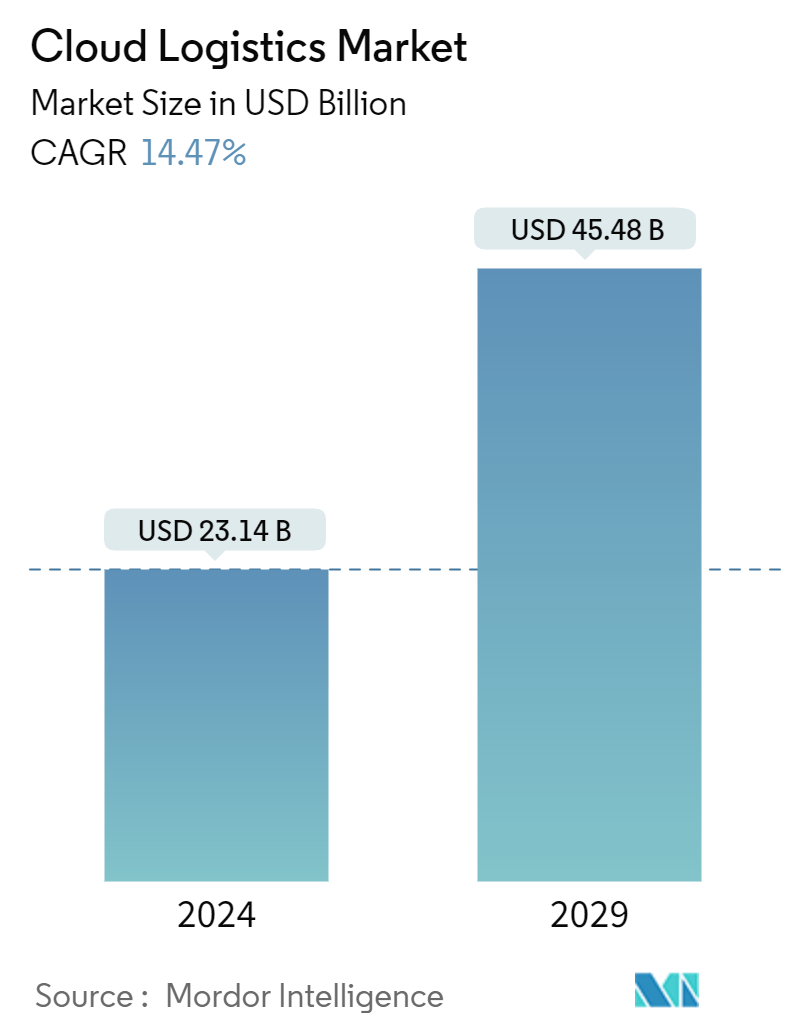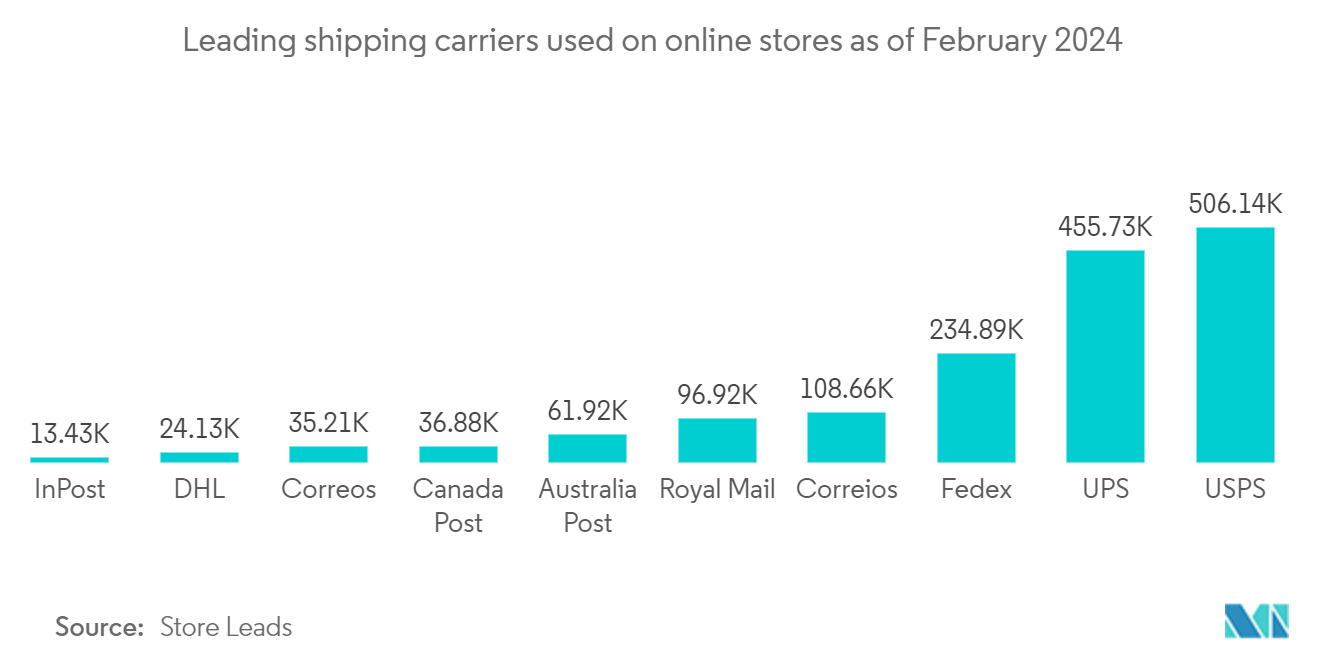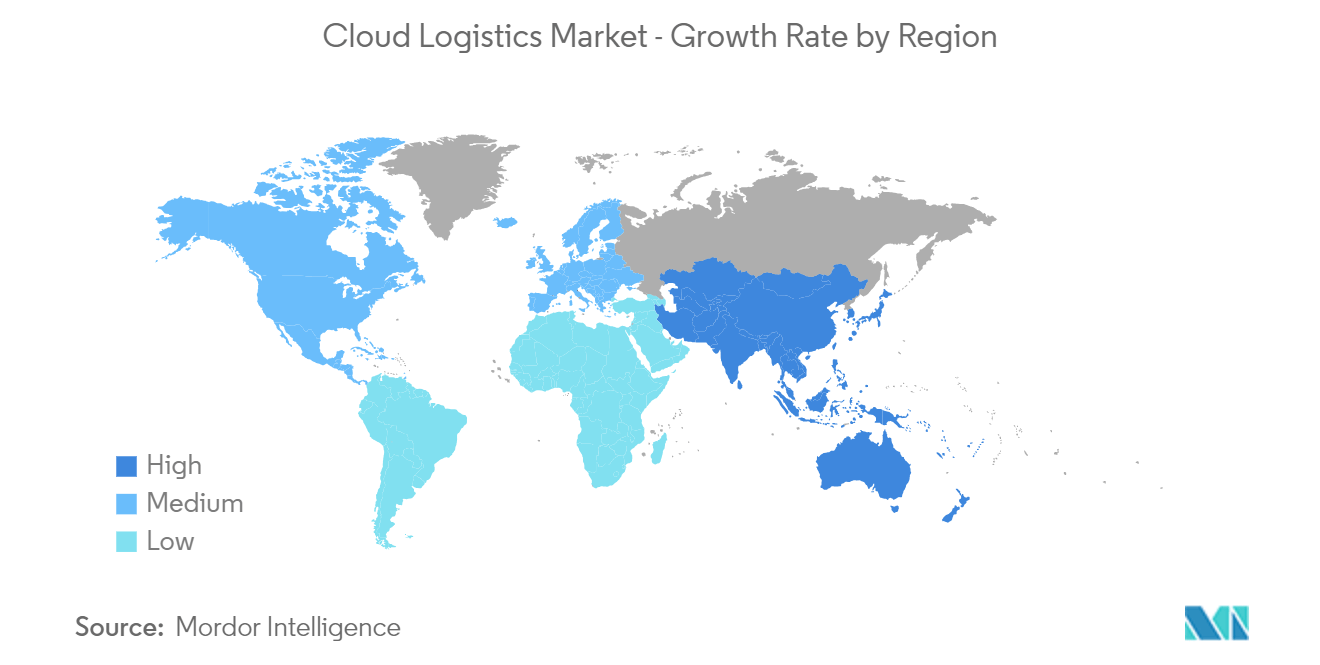Cloud Logistics Market Size

| Study Period | 2019 - 2029 |
| Market Size (2024) | USD 23.14 Billion |
| Market Size (2029) | USD 45.48 Billion |
| CAGR (2024 - 2029) | 14.47 % |
| Fastest Growing Market | Asia Pacific |
| Largest Market | North America |
Major Players
*Disclaimer: Major Players sorted in no particular order |
Cloud Logistics Market Analysis
The Cloud Logistics Market size is estimated at USD 23.14 billion in 2024, and is expected to reach USD 45.48 billion by 2029, growing at a CAGR of 14.47% during the forecast period (2024-2029).
- Cloud logistic solutions help businesses manage inventory, track shipments, and plan logistics, meeting the global demand for efficiency. These solutions also support customs compliance, customer service, invoicing, and specialized functions, such as transportation management for fleet and route planning, which are expected to drive market demand in the coming years.
- The increasing adoption of cloud logistic software for its flexibility, easy updates, and economic benefits supports the market's growth. The advantage of using cloud-based logistics software on a subscription basis is that users have a predictable monthly cost, which can help their OPEX estimations easily and support the market's growth worldwide.
- Businesses increasingly adopt cloud-based logistics solutions, leveraging software like a warehouse management system (WMS) in a software-as-a-service (SaaS) framework. This cloud iteration streamlines WMS installation and deployment, leading to fast implementation and significant cost efficiencies. Consequently, many enterprises embrace the cloud transformation to manage their inventory and facilitate universal data access, driving the market during the forecast period.
- However, cloud logistic solutions use cloud infrastructure for data storing and processing, increasing the risk of Data security in the business environment. This data breach risk can be critical for operational compliance and customer satisfaction. Compromised databases could lead to shipments being held at ports or refused entry. Additionally, customer data breaches can damage reputation and potential legal challenges for enterprises, restricting the adoption of cloud-based logistic solutions in the end-user industries worldwide, which could be a challenge for market growth.
- The macroeconomic trends, including the digital strategy adoptions among the end-user vertical after the covid-19 pandemic, supporting the growth of factory automation trends, and the increasing adoptions of analytics and IIoTs are supporting the demand for the market. The application of cloud logistic software in automating supply chain and logistics in line with the emergence of AI&ML and Cloud Computing technologies in logistic management in the post-COVID-19 pandemic has fueled the market growth.
Cloud Logistics Market Trends
Consumer Goods and Retail Segment Contributes Significantly to the Market Share
- Logistic solutions are essential for maintaining timely and cost-effective product deliveries in retail management. This supports the demand for cloud logistic solutions due to their application in inventory management, transportation, warehousing, and order fulfillment in the retail sector, which would fuel the market growth in line with the development of the retail industry worldwide.
- The e-commerce growth, in line with the increasing consumer spending for online purchases and the enhancement of omnichannel sales channel expansions by the retail vendors, is fueling the cross-border transactions in the retail landscape, which has been fueling the demand for 3rd party logistic providers, freight providers, and others in the industry, supporting the demand for the cloud logistic software adoptions during the forecast period.
- Freight forwarders in the retail supply chain have started to adopt cloud-based solutions, mainly because they need a SaaS model of logistic software to streamline their supply chain activities over the Internet without needing internal infrastructure or hardware, fueling the market growth in the retail industries. Additionally, the dependency of online retailing and the selling of consumer goods products on logistic providers and shippers support the demand for the market in the retail sectors.
- Stationery and office supplies retailers are increasingly using cloud-based warehouse management systems to streamline their online store inventories, highlighting the sector's growth potential during the forecast period. Advancements like cloud computing in e-commerce logistics bolster efficient deliveries and cost-effective supply chain management, further propelling market expansion.
- Cloud logistics empowers retailers with real-time, accurate information on their shipment locations, enhancing their ability to address delays or disruptions. Automating the supply chain through cloud computing increases efficiency by saving valuable time and resources. Additionally, modular cloud logistics platforms allow a business to integrate its existing data infrastructure with logistics provider platforms via APIs, ensuring a streamlined and seamless flow of data on every link in the supply chain, which supports the growth of cloud logistic solutions in the small scale retailers due to their increasing demand for low-cost logistic management software for business efficiencies.

Asia Pacific Expected to Witness Significant Market Growth
- The transportation and logistics industry in the Asia Pacific has been becoming dynamic and complex, with changes driven by economic growth, increasing consumer demands, and technological advances. Additionally, with some of the world's most important ports, airports, and critical manufacturing zones, the Asia-Pacific region has transformed into a hub for global supply chains, which would raise the demand for the cloud logistics market in the future.
- The region includes developing economies, such as India and other Southeast Asian countries, and significant global manufacturing countries, such as China, South Korea, and Japan, among others, supporting the manufacturing, retail, and other sectors' growth in the region, which would fuel the demand outsourced logistic providers for the transportations of raw materials, semi-finished and finished goods across the value chains of different end-user industries operating in the region, which would fuel the market growth.
- The growth of SMEs and the governmental support for in-house manufacturing capabilities expansions in the emerging economies in the region, such as the Make in India initiatives and others, are increasing the number of logistic providers and supply chain activities in the area, creating an opportunity for market growth in the future.
- Supply chain and logistic automation are gaining traction in the region in line with the growth of digitalization strategy among enterprises. In December 2023, Fujitsu introduced a cloud-based service in Japan, focusing on standardizing and visualizing logistics data. This service caters to shippers, logistics firms, and vendors, increasing sustainability by leveraging logistics data. This initiative would facilitate the safe and easy sharing of insights with internal stakeholders, showing a rising demand for cloud-based logistics solutions in the APAC region during the forecast period.
- Cloud service providers are expanding their data center footprint in Asia to cater to the surging demand. Increasing their regional infrastructure allows these providers to offer their customers faster and more secure cloud services. Additionally, this would ensure compliance with stringent local data privacy laws and pave the way for increasing acceptance of cloud logistics solutions across the Asia-Pacific.

Cloud Logistics Industry Overview
The Cloud Logistics Market is set to witness a moderately fragmented competitive landscape, primarily due to the rise of numerous small and medium-sized solution providers. These providers are actively partnering with companies from various sectors to drive the adoption of their cloud-based logistics solutions. Additionally, key industry players, such as IBM Corporation, SAP SE, Zoho Corporation, Magaya Corporation, and Oracle Corporation, are enhancing the capabilities of their solutions to stay competitive.
- February 2024 - Oracle Corporation announced plans to enhance its Supply Chain and Manufacturing (SCM) Fusion Cloud, aiming to empower enterprises in logistics management. The upgrades, set to roll out, would increase the Oracle Transportation Management and Oracle Global Trade Management applications. These enhancements encompass advanced business intelligence tools, improved logistics network modeling, a fresh trade incentive initiative, and an enhanced Transportation Management Mobile app, which shows the technological advancement by the solution offering from the exhisting market vendors.
Cloud Logistics Market Leaders
-
IBM Corporation
-
SAP SE
-
Zoho Corporation
-
Magaya Corporation
-
Oracle Corporation
*Disclaimer: Major Players sorted in no particular order

Cloud Logistics Market News
- April 2024 - Transflo, a company in transportation technology, announced its strategic alliance with Mastery Logistics Systems (Mastery), the creator of MasterMind TMS, an advanced enterprise transportation management system designed to streamline the connection between systems, individuals, and data. Through this partnership, these two would provide a complete cloud-to-cloud (C2I) integration, elevating the efficiency and precision of freight management processes, which would support the market growth.
- September 2023 - Kale Logistics Solutions (Kale), a global provider of vertical SaaS logistics platforms, has completed its Series B funding round. The company secured USD 30 million in capital. This funding would accelerate Kale's expansion and enhance its SaaS solutions and cloud applications suite. Kale focuses on the global logistics industry, primarily focusing on airports and seaports, showing the increasing demand for cloud-based solutions.
Cloud Logistics Market Report - Table of Contents
1. INTRODUCTION
- 1.1 Study Assumptions and Market Definition
- 1.2 Scope of the Study
2. RESEARCH METHODOLOGY
3. EXECUTIVE SUMMARY
4. MARKET INSIGHTS
- 4.1 Market Overview
-
4.2 Industry Attractiveness - Porter's Five Forces Analysis
- 4.2.1 Bargaining Power of Suppliers
- 4.2.2 Bargaining Power of Consumers
- 4.2.3 Threat of New Entrants
- 4.2.4 Threat of Substitutes
- 4.2.5 Intensity of Competitive Rivalry
- 4.3 Regulatory Landscape
- 4.4 Assessment of Impact of macroeconomic trends
- 4.5 Ecosystem/Value Chain Analysis
5. MARKET DYNAMICS
-
5.1 Market Drivers
- 5.1.1 Rising adoption in SMEs due to subscription pricing model
- 5.1.2 Integration of IoT and Analytics Technology
-
5.2 Market Restraints
- 5.2.1 Interoperability issues coupled by data security challenges
- 5.3 Key use cases and case studies
- 5.4 Role of cloud logistics solutions (3PL and 4PL, Shippers, Freight Forwarders, Carriers and others)
- 5.5 Logistics industry trends
6. MARKET SEGMENTATION
-
6.1 By Organization Size
- 6.1.1 SMEs
- 6.1.2 Large Enterprises
-
6.2 By End-user Industry
- 6.2.1 Consumer Goods and Retail
- 6.2.2 Healthcare and Life Sciences
- 6.2.3 Oil & Gas
- 6.2.4 Manufacturing
- 6.2.5 Energy & Power
- 6.2.6 Other End-user Industries
-
6.3 Geography
- 6.3.1 North America
- 6.3.2 Europe
- 6.3.3 Asia Pacific
- 6.3.4 Latin America
- 6.3.5 Middle East and Africa
7. COMPETITIVE LANDSCAPE
-
7.1 Company Profiles
- 7.1.1 IBM Corporation
- 7.1.2 SAP SE
- 7.1.3 Oracle Corporation
- 7.1.4 Magaya Corporation
- 7.1.5 Microsoft Corporation
- 7.1.6 Detrack Systems
- 7.1.7 Zoho Corporation
- 7.1.8 Trimble Inc.
- 7.1.9 The Descartes Systems Group Inc
- 7.1.10 ShipBob, Inc
- *List Not Exhaustive
8. INVESTMENT ANALYSIS
9. FUTURE OF THE MARKET
** Subject To AvailablityCloud Logistics Industry Segmentation
The cloud logistics market study tracks the revenue generated from the sale of cloud-based logistics platforms offered by the vendors to track and manage the logistics operations and provide visibility of in-transit goods/products.
The Cloud Logistics Market is Segmented by Organization Size (SMEs, Large Enterprises), End-User Industry (Consumer Goods and Retail, Healthcare and Life Sciences, Energy, Oil and gas, Manufacturing, Energy and power, and Other End-User Industries), and Geography.
The Market Sizes and Forecasts are Provided in USD for all the Above Segments.
| By Organization Size | SMEs |
| Large Enterprises | |
| By End-user Industry | Consumer Goods and Retail |
| Healthcare and Life Sciences | |
| Oil & Gas | |
| Manufacturing | |
| Energy & Power | |
| Other End-user Industries | |
| Geography | North America |
| Europe | |
| Asia Pacific | |
| Latin America | |
| Middle East and Africa |
Cloud Logistics Market Research FAQs
How big is the Cloud Logistics Market?
The Cloud Logistics Market size is expected to reach USD 23.14 billion in 2024 and grow at a CAGR of 14.47% to reach USD 45.48 billion by 2029.
What is the current Cloud Logistics Market size?
In 2024, the Cloud Logistics Market size is expected to reach USD 23.14 billion.
Who are the key players in Cloud Logistics Market?
IBM Corporation, SAP SE, Zoho Corporation, Magaya Corporation and Oracle Corporation are the major companies operating in the Cloud Logistics Market.
Which is the fastest growing region in Cloud Logistics Market?
Asia Pacific is estimated to grow at the highest CAGR over the forecast period (2024-2029).
Which region has the biggest share in Cloud Logistics Market?
In 2024, the North America accounts for the largest market share in Cloud Logistics Market.
What years does this Cloud Logistics Market cover, and what was the market size in 2023?
In 2023, the Cloud Logistics Market size was estimated at USD 19.79 billion. The report covers the Cloud Logistics Market historical market size for years: 2019, 2020, 2021, 2022 and 2023. The report also forecasts the Cloud Logistics Market size for years: 2024, 2025, 2026, 2027, 2028 and 2029.
Cloud Logistics Industry Report
Statistics for the 2024 Cloud Logistics market share, size and revenue growth rate, created by Mordor Intelligence™ Industry Reports. Cloud Logistics analysis includes a market forecast outlook for 2024 to 2029 and historical overview. Get a sample of this industry analysis as a free report PDF download.



